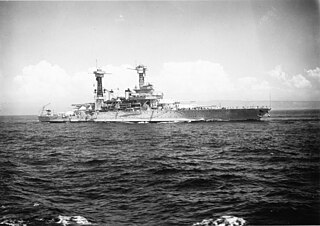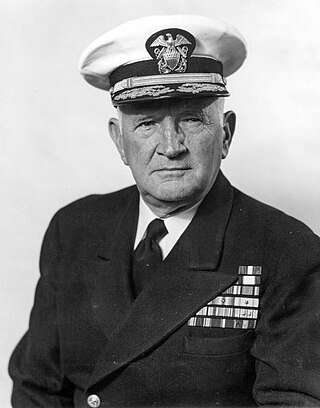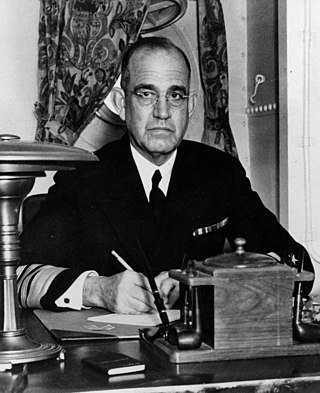
The United States Pacific Fleet (USPACFLT) is a theater-level component command of the United States Navy, located in the Pacific Ocean. It provides naval forces to the Indo-Pacific Command. Fleet headquarters is at Joint Base Pearl Harbor–Hickam, Hawaii, with large secondary facilities at Naval Air Station North Island, California.

USS Pennsylvania (BB-38) was the lead ship of the Pennsylvania class of super-dreadnought battleships built for the United States Navy in the 1910s. The Pennsylvanias were part of the standard-type battleship series, and marked an incremental improvement over the preceding Nevada class, carrying an extra pair of 14-inch (356 mm) guns for a total of twelve guns. Named for the Commonwealth of Pennsylvania, she was laid down at the Newport News Shipbuilding and Drydock Company in October 1913, was launched in March 1915, and was commissioned in June 1916. Equipped with an oil-burning propulsion system, Pennsylvania was not sent to European waters during World War I, since the necessary fuel oil was not as readily available as coal. Instead, she remained in American waters and took part in training exercises; in 1918, she escorted President Woodrow Wilson to France to take part in peace negotiations.

USS Nevada (BB-36), the third United States Navy ship to be named after the 36th state, was the lead ship of the two Nevada-class battleships. Launched in 1914, Nevada was a leap forward in dreadnought technology; four of her new features would be included on almost every subsequent US battleship: triple gun turrets, oil in place of coal for fuel, geared steam turbines for greater range, and the "all or nothing" armor principle. These features made Nevada, alongside her sister ship Oklahoma, the first US Navy "standard-type" battleships.

USS Utah (BB-31/AG-16) was the second of two Florida class dreadnought battleships. The first ship of the United States Navy named after the state of Utah, she had one sister ship, Florida. Utah was built by the New York Shipbuilding Corporation, laid down in March 1909 and launched in December of that year. She was completed in August 1911, and was armed with a main battery of ten 12-inch (305 mm) guns in five twin gun turrets.

USS California (BB-44) was the second of two Tennessee-class battleships built for the United States Navy between her keel laying in October 1916 and her commissioning in August 1921. The Tennessee class was part of the standard series of twelve battleships built in the 1910s and 1920s, and were developments of the preceding New Mexico class. They were armed with a battery of twelve 14-inch (356 mm) guns in four three-gun turrets. California served as the flagship of the Battle Fleet in the Pacific Ocean for the duration of her peacetime career. She spent the 1920s and 1930s participating in routine fleet training exercises, including the annual Fleet Problems, and cruises around the Americas and further abroad, such as a goodwill visit to Australia and New Zealand in 1925.

USS Tennessee (BB-43) was the lead ship of the Tennessee class of dreadnought battleships built for the United States Navy in the 1910s. The Tennessee class was part of the standard series of twelve battleships built in the 1910s and 1920s, and were developments of the preceding New Mexico class. They were armed with a battery of twelve 14-inch (356 mm) guns in four three-gun turrets. Tennessee served in the Pacific Fleet for duration of her peacetime career. She spent the 1920s and 1930s participating in routine fleet training exercises, including the annual Fleet Problems, and cruises around the Americas and further abroad, such as a goodwill visit to Australia and New Zealand in 1925.

USS Maryland (BB-46), also known as "Old Mary" or "Fighting Mary" to her crewmates, was a Colorado-class battleship. She was the third ship of the United States Navy to be named in honor of the seventh state. She was commissioned in 1921, and serving as the flagship of the fleet, cruised to Australia, New Zealand, and Brazil.

USS West Virginia (BB-48) was the fourth dreadnought battleship of the Colorado class, though because Washington was cancelled, she was the third and final member of the class to be completed. The Colorado class proved to be the culmination of the standard-type battleship series built for the United States Navy in the 1910s and 1920s; the ships were essentially repeats of the earlier Tennessee design, but with a significantly more powerful main battery of eight 16-inch (406 mm) guns in twin-gun turrets. West Virginia was built between her keel laying in 1920 and her commissioning into the Navy in 1923. The ship spent the 1920s and 1930s conducting routine training exercises, including the typically annual Fleet Problems, which provided invaluable experience for the coming war in the Pacific.

USS Wyoming (BB-32) was the lead ship of her class of dreadnought battleships and was the third ship of the United States Navy named Wyoming, although she was only the second named in honor of the 44th state. Wyoming was laid down at the William Cramp & Sons in Philadelphia in February 1910, was launched in May 1911, and was completed in September 1912. She was armed with a main battery of twelve 12-inch (305 mm) guns and capable of a top speed of 20.5 kn.

Jesse Barrett "Oley" Oldendorf was an admiral in the United States Navy, famous for defeating a Japanese force in the Battle of Leyte Gulf during World War II. He also served as commander of the American naval forces during the early phase of the Battle of the Caribbean. In early 1942, a secret group of senior Navy officers empaneled by President Franklin D. Roosevelt assessed him as one of the 40 most competent of the 120 flag officers in the Navy.

Isaac Campbell Kidd was a rear admiral in the United States Navy. He was the father of Admiral Isaac C. Kidd Jr. Kidd Sr. was killed on the bridge of USS Arizona during the Japanese attack on Pearl Harbor. The highest-ranking casualty at Pearl Harbor, he became the first U.S. Navy flag officer killed in action in World War II as well as the first killed in action against any foreign enemy.

USS Crommelin (FFG-37), twenty-eighth ship of the Oliver Hazard Perry-class of guided-missile frigates, was named for five brothers: Rear Admiral John G. Crommelin (1902–1996), Vice Admiral Henry Crommelin (1904–1971), Commander Charles L. Crommelin (1909–1945), Lieutenant Commander Richard Crommelin (1917–1945), and Captain Quentin C. Crommelin (1919–1997). The Crommelin brothers were the only group of five siblings ever to graduate from the United States Naval Academy. Four of them became pilots, and Time magazine dubbed them "The Indestructibles." The brothers saw action in more than ten campaigns in the Pacific Theater. Henry, the second-oldest, became a Surface Warfare Officer while Richard and Charles died in combat as naval aviators in 1945. Individually and as a fighting family, they gained fame in World War II, attaining outstanding combat records and multiple decorations. Crommelin (FFG-37) is the first ship of that name in the United States Navy.

Vice Admiral William Satterlee Pye was a U.S. Navy officer who served during World War I and World War II, but never saw combat action. His last active-duty appointment was as President of the Naval War College, in 1942–1946. His awards included the Navy Cross for his distinguished service as a staff officer during World War I.

James Otto Richardson was an admiral in the United States Navy who served from 1902 to 1947.
The United States Battle Fleet or Battle Force was part of the organization of the United States Navy from 1922 to 1941.

Theodore Edson Chandler was a rear admiral of the United States Navy during World War II, who commanded battleship and cruiser divisions in both the Atlantic and Pacific Fleets. He was killed in action when a Japanese kamikaze aircraft struck his flagship Louisville on January 6, 1945, in Lingayen Gulf, Philippine Islands. He died the next day, January 7, 1945, from severely scorched lungs. He was the last of five US Navy admirals killed in battle during WWII, including: Isaac C. Kidd ; Norman Scott and Daniel J. Callaghan ; and Henry M. Mullinnix.
The Standard-type battleship was a series of thirteen battleships across five classes ordered for the United States Navy between 1911 and 1916 and commissioned between 1916 and 1923. These were considered super-dreadnoughts, with the ships of the final two classes incorporating many lessons from the Battle of Jutland.

Rear Admiral Herbert James Ray was an officer in the United States Navy who served in World War I and World War II. A 1914 graduate of the Naval Academy, he served on the submarines USS H-2 and N-3 during World War I. In March 1942, as Chief of Staff and Aide to the Commandant of the Sixteenth Naval District, Rear Admiral Francis W. Rockwell, he participated in General Douglas MacArthur's escape from the Philippines. In Australia, he served with MacArthur's General Headquarters, Southwest Pacific Area staff. In September 1943, he became Captain of the battleship USS Maryland, which he commanded in the Battle of Tarawa, Battle of Kwajalein, Battle of Saipan and the Battle of Peleliu. In October 1944, he participated in the Battle of Surigao Strait, in which Maryland joined the other battleships in engaging the Japanese battleships Fusō and Yamashiro and their escorts. Ray left Maryland in December 1944, and was promoted to Commodore and appointed deputy director of the Naval Division of the US Control Group Council for Germany. After VE Day, he became the Junior United States Member of the Tripartite Naval Commission in Berlin. He retired from the Navy on 30 June 1949, and received a tombstone promotion to rear admiral due to his combat decorations.
The Commander, Battleship Force, Pacific Fleet (COMBATPAC) was the title, from 1922 to 1944, of the United States Navy officer who commanded the battleships of the larger United States Battle Fleet in the Pacific.

William Rea Furlong was United States Navy Rear admiral during World War II, who served as the Chief of Naval Ordnance from 1937 to 1941. After Japanese Attack on Pearl Harbor, Furlong was tasked with the salvaging and repairing of the sunken U.S. ships.

















